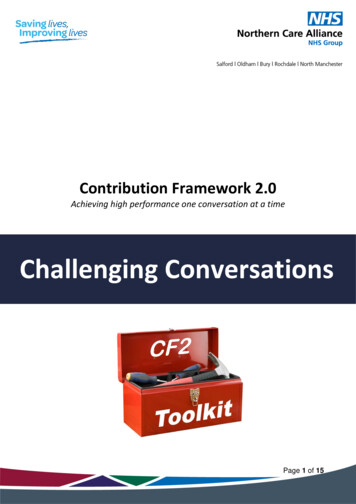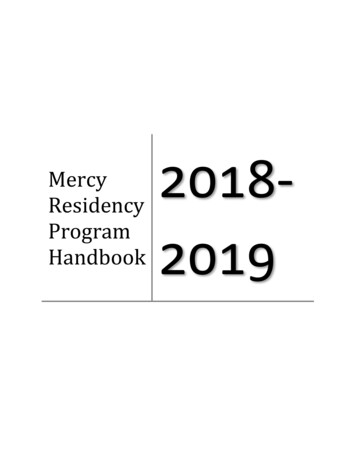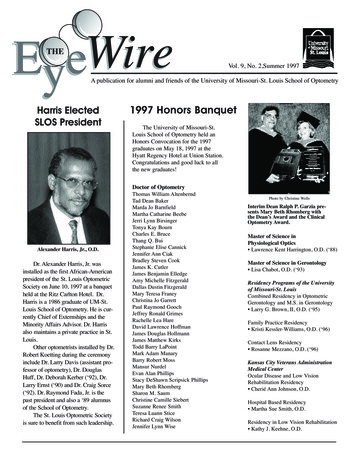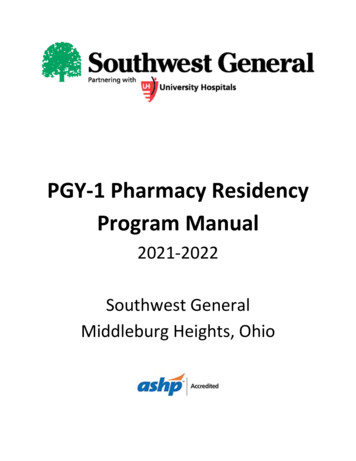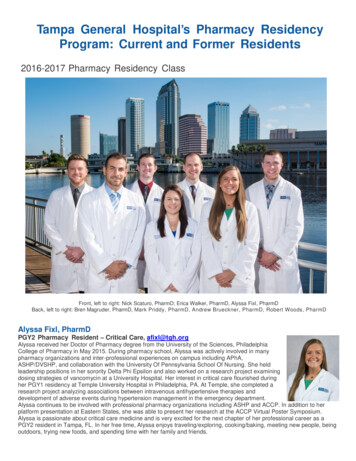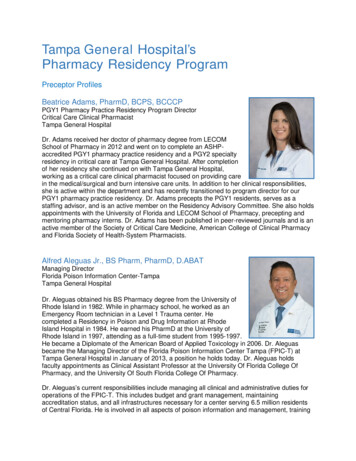
Transcription
Accreditation Council for Graduate Medical EducationConversations with the Residency ReviewCommittee for Internal Medicine (RRC-IM):Meeting the IM Residency ProgramRequirementsBen Clyburn, MD, Vice-Chair-electJerry Vasilias, PhD, Executive Director
Table of Contents General Description of the RRC-IMSummary of Actions Taken in 2010Frequent Citations for ProgramsGuidance on Compliance with RequirementsNew Practices with Site VisitsResident SurveyNext Accreditation System
RRC Composition 3 nominating organizations - ABIM, ACP, AMACurrently17 voting members6 year terms -- except resident (2 years)Generalists and subspecialistsCardiology, Critical Care Medicine, Endocrinology, Gastroenterology,General Internal Medicine, Geriatric Medicine, Infectious Diseases,Medicine-Pediatrics, Nephrology, Pulmonology/Critical Care Medicine,Sleep Medicine Geographic DistributionCA, CT, DC, FL, LA, IN, MA, NY, MN, NM, PA, RI, SC, TX, WA Ex-officio members from each nominatingorganization (non-voting)
Who is the RRC-IM? Committee MembersLynne M. Kirk, MD – ChairJames A. Arrighi, MD – Chair electBeverly M.K. Biller, MDHeather Brislen, MD *Andres Carrion, MD*E. Benjamin Clyburn, MD – ViceChair electJohn Fisher, MD *John Fitzgibbons, MD* New to RRC since July 2010Andrew S. Gersoff, MD *Betty Lo, MD *Furman McDonald, MD *Susan Murin, MDVictor J. Navarro, MDAndrea Reid, MD *Ilene Rosen, MD *Stephen M. Salerno, MDJennifer C. Thompson, MD
RRC-IM Oversight# of IM Programs: Core and Fellowship400% of IM ProgramsRelative to AllAccredited Programs350300IM23%250200150100500non-IM77%
Review of Programs Peer Review Reviewers use the following information to determine compliancewith the requirements:programinformationform (PIF)site visitor’sreportresidentsurveyfindingsboardscores Program Directors: questions in the PIF correspond to programrequirements Reviewers present program to Committee Committee determines degree of compliance and assignsaccreditation status along with review cycle, range of 1-5 years
Summary of Activities 2010 The RRC-IM meets threetimes a year – January,May, and SeptemberTypes of Reviews– A fourth summer meeting isa business/policy meeting The RRC-IM reviewed546 programs– Average per meeting: 20 core 140 subspecialty programs 20 interim reports(progress & duty hours reports)coresubsinterim
Summary of Actions 2010Core Internal MedicineNumber of Core IMPrograms Reviewed72Initial Accreditation4Continued Accreditation52Proposed Probation1Probation1Progress Reports11Voluntary Withdrawal35 years44.2%1 year5.8%2 years3 years7.7%19.2%4 years23.1%
Summary of Actions in 2010Subspecialty ProgramsNumber of SubspecialtyPrograms Reviewed1 year3.5%474Initial Accreditation29Continued Accreditation347Proposed Withhold15Withhold4Voluntary Withdrawal32Progress Reports45Duty Hour Reports25 years52.7%2 years11.5% 3 years17.0%4 years15.3%
Most Frequent Citations in 2010Total # of core programs reviewed 72Total # of citations 284; approximately 3.9 citations/program1. Citations related to curricular elements inadequate continuity experience; no competency based G &O; inadequate exposure in IM subs2. Citations related to program personnel subspecialty education coordinator(s) not certified; MICU director not certified; consultations from other clinical services not done in a timelymanner; inadequate # of other health care professionals
Most Frequent Citations3. Citations related to evaluation of residents semiannual evaluation not documented; faculty do not routinely provide verbal feedback at the end of arotation; inadequate summative evaluation; evaluations not competency based; inadequate multi-source evaluation4. Citations related to evaluation of program no formal systematic review of the program no action plan to address deficiencies; residents not included in annual review of the program; faculty development not tracked and monitored; does not share faculty performance data;
Most Frequent Citations5. Citation related to institutional issues environment of fear/intimidation; no program letter of agreement; internal review did not occur mid-cycle; * internal review committee does not include all requiredcomponents; *6. Service to Education Imbalance excessive reliance on residents to meet service needs; inadequate teaching ratio; Residents ongoing care activities exceeding patient caps; service responsibilities not limited to patients on the teachingservice
Communicating with PDs Weekly e-communication Contains GME information: New requirements, newsletters; updates onACGME issues/initiatives E-mail status of programs on RRC agenda Within 5 days after meeting will receive email w/status and review cycle Notification letter will be posted on Accreditation DataSystem (ADS). Hard copies of letters not provided Letter is posted approximately 8 weeks following meeting Proposed adverse actions posted within 4 weeks of meeting
ResourcesWho should I contact Questions related to requirements or notification letter: Jerry Vasilias (312) 755-7477, jvasilias@acgme.org Felicia Davis (312) 755-7445, fdavis@acgme.org Karen Lambert (312) 755-5785, kll@acgme.org Questions related to PIF content: Danny Hart (312) 755-7440, dhart@acgme.org Questions related to complement increases: Jessalynn Van Ausdall (312) 755-5784, jvanausdall@acgme.org Questions related to the ADS/Technical problems with PIF: Raquel Eng (312) 755-7120, reng@acgme.org Questions related to site visit: Ingrid Philibert (312) 755-5003, iphilibert@acgme.org Jane Shapiro (312) 755-5015, jshapiro@acgme.org Penny Lawrence (312) 755-5014, pil@acgme.org
Guidance on Interpretation of CommonProgram Requirements PD Guide to the Common es/nav commonpr.aspProvides PDs: Explanations of the intent of most of the commonrequirements (particularly competency-based) Suggestions for implementing requirements andtypes of documentation expected.
Guidance on Interpretation of IMProgram Requirements FAQ contain clarification and interpretation of programrequirements Program Requirements are updated every 5-7 years, so, FAQsprovide additional information quicker Core IM FAQ located here:http://www.acgme.org/acWebsite/RRC 140/Internal Medicine Residency Programs FAQ.pdf
New Core FAQsNight Float vs Night Medicine Question: What is“ night medicine" and how does it relate to/differfrom "night float"? Answer: "Night medicine" is defined as a rotation of 2 or more consecutivenights of inpatient clinical duty which includes the following: Faculty interaction that allows for meaningful evaluation of residentperformance, including the opportunity for bedside teaching andobservation of direct patient care; Interaction with the patient’s primary daytime physicians; A predefined cohort of patients for which the resident is responsible; Input into the ongoing care of the patient during his/her hospitalization; A defined curriculum with G&Os; and Accessibility of consultants (in person or by phone).Continued on next page .
New Core FAQsNight Float vs Night Medicine (continued) Question: What is“ night medicine" and how does it relate to/differfrom "night float"? This applies to all hospital inpatient floor rotations. Emergency departmentrotations are not included. If these criteria are met for night duty on ICUrotations, then the night duty counts towards ICU time and not towards“night medicine.” The annual and total limits of “night float” as specified in the PRs will notchange: “night float” must not exceed 2 months per year nor more than 4months across the three years of residency. However, programs can extend the sum of “night float” and “nightmedicine” to 5 months over the three year residency. Programs are encouraged to incorporate the criteria mentioned above for“night medicine” into all night duty experiences. (May 2011 RC Meeting).
New FAQsPreceptors in the Ambulatory ClinicQUESTION: Can a family medicine-trained faculty member superviseIM residents in the continuity clinic?ANSWER: The RC allows the PD, under rare circumstances, to appoint anexperienced non-internist with special expertise to supervise inambulatory setting (e.g., a family medicine physician with extensiveambulatory experience, procedural or other pertinent training). It is expected that the site director for each continuity clinic be aninternist and the vast majority of preceptors be internists (October2010 RC Meeting).
New FAQsDepartment of Medicine QUESTION: We do not have a traditional/ conventionaldepartment of medicine. Rather, we have a serviceline/institute/organization in which our internal medicine facultyand core internal medicine program are seated. Does this meetthe program requirement? ANSWER: For a core internal medicine program, the sponsoringinstitution must establish the educational program within adepartment of medicine or an administrative unit whose primarymission is the advancement of internal medicine resident educationand patient care. (July 2011 RC Meeting)
New FAQsInterprofessional teams QUESTION: Must every interprofessional team includerepresentation from every profession listed in the requirement?II.D.7. There must be services available from other health care professionalssuch as nurses, social workers, case managers, language interpreters,dieticians, etc. to assist with patient care.II.D.8. Consultations from other clinical services must be available in a timelymanner in all care settings where the residents work. All consultationsshould be performed by or under the supervision of a qualified specialist. ANSWER. No. The RRC recognizes that the needs of specificpatients change with their health status and circumstances. Theintent of the requirement is to assure that the program has access tothese professional and paraprofessional personnel and thatinterprofessional teams will be constituted as appropriate and asneeded (September 2011 RC Meeting).
should have 10, must have 8hours between duty periods 8 to 10 hoursLess than 8 hoursPGY-1Scheduled or expected dutyhour period should beseparated by 10 hours. Ifresidents get less than 10 butat least 8 hours, PDs does nothave to document reason.PGY-1s are not allowed tohave less than 8 hours offbetween duty periods.PGY2-3Residents should receive 8hours off between duty periodsDocumentation of reason foreach episode where residentremains on duty for less than8 hours (PR IV.G.5.c).(1).(b))(residents intheir finalyears ofeducation)
RC-Newsletter Sent to all core, med-peds and subspecialty programdirectors, coordinators, and DIOs Most recent newsletters:http://www.acgme.org/acWebsite/RRC 140 news/InternalMedicine Newsletter Jul11.pdf Highlights: Definitions in New Common Program RequirementsNight Float / Night Medicine FAQNew use for Resident SurveyFrequent citations for core and subs Annual; but anticipate another newsletter by end of year.
Minor Edits to the core PIFEdited several existing questions. Edited question related to faculty inpatient/outpatient data to Y/N instead of narrativeEdited question related to direct observation tools used are identifiedEdited question about cost effective careRemoved several questions b/c did not provide useful information; Removed several competency question related to who is involved with multisourceevaluation because redundant with info ACGME collectsRemoved individual questions under each competency related to how program usesassessment to determine if resident is performing at appropriate level andcondensed into one questionAdded several questions Added question asking # of weeks of night float and night medicine, and whetherprogram has a curriculum for night medicineAdded 2 questions to continuity: (1) how does program demonstrate that residentshave effectively established long term healing relationships with their patients, and(2) how does program ensure longitudinal relationship b/w residents andsupervisors.
Site Visit:Newer Practice for Resident Input Implemented in 2010, residents in programs undergoing asite visit are asked to submit a consensus list of five programstrengths and opportunities for improvement directly to theassigned field staff representative. The list is held confidential – residents are asked to e-mail itto the field representative, or bring it to the site visit interview. The information offers site visitors insight into residents’unique perspective on their program and the accreditationstandards.
Site VisitUse of “Tracer Method” Site Visit letters announcing visits after July 1 havelanguage about “Tracer Method.” “Use of this approach by the ACGME field staff is intendedto shift the emphasis of the site visit from the review ofpolicies and documentation to actual processes andfunctions to which the policies pertain. It also seeks topromote an enhanced focus on programs’ continuousimprovement efforts.” 0711 final.pdf
Resident Survey (RS):General Information Administered annually Jan-May 70% completion rate to see summary report Question in RS relate to 5 content areas:Faculty, Educational Content, Evaluation, Resources,Duty Hours. In 2009: All core programs and fellowships with 4 or moreneed to complete survey annually In 2010: several difficult questions in RS were modified In 2011: RS was revised based on input from residentsand survey experts In 2012: RS will be revised again to align with new PRs.
Resident Survey (RS) 2006: ACGME Board gave Monitoring Committeeresponsibility to oversee duty hour (DH) Review national reports and recommend to RCs how to handleprogram outliers programs with substantial non-compliance rates 2010 & 2011: Mon Com had recommendationssignificant non-compliance with DH issues with other parts of the RS; and DH issues over multiple years (2 of 3).
Resident Survey (RS)8,576 ACGME accredited programs5,798 (or 65.2% of all accredited)programs participated in the RS (allcore programs subspecialtyprograms w/ 4 or more fellows)173 programs (or 3% of those thatparticipated in the survey) wereidentified as having substantial noncompliance issues w/ DH. 53 were IM core or subs 45 were first time offenders 4 DH other areas(2 core; 2 subs) 4 DH in 2 of last 3 yrs(all core)For the 4 core IM programs (or less than one % of all programs that participated inthe RS) that had DH issue over multiple years Mon Com is asking the RC to reviewthese program’s accreditation history and consider shortening their review cycles.
Next Accreditation System (NAS)Attributes Accreditation in the future, will be different from thecurrent model. Dr Nasca will provide community more details about theNext Accreditation System (NAS) very soon. Broadly speaking, NAS will Foster innovation; reward excellenceLess frequent revisions to program requirements.Longer accreditation cyclesContinuously monitors outcomes and other predictivemeasures Continuously holding sponsoring institutions responsiblefor oversight of educational and clinical systems
Next Accreditation System (NAS)Elements Formal in depth self study and site visit every 10 years RC received data continuously – at least annually RC tracks data on each program Milestone performance data Resident survey data Faculty survey data Board certification performance data Key quality/patient safety data
Questions?
Conversations with the Residency Review Committee for Internal Medicine (RRC-IM): Meeting the IM Residency Program Requirements Ben Clyburn, MD, Vice -Chair-elect . ABIM, ACP, AMA Currently17 voting members 6 year terms -- except resident (2 years)


